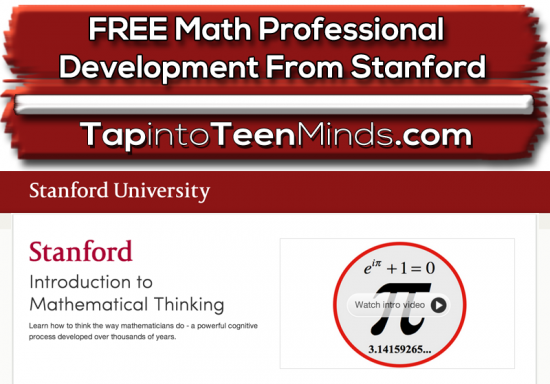Introduction to Mathematical Thinking – FREE Online Math Course
Take advantage of some FREE online learning through Stanford University by enrolling in Keith Devlin‘s course Introduction to Mathematical Thinking. This free online course is one of many offerings from Stanford University without a cost.
While the course officially began on February 3rd, registration is still open. There is no indication of when the course will close for new participants, so I would jump on the opportunity now if you are interested.
What the course covers:
The goal of the course is to help you develop a valuable mental ability – a powerful way of thinking that our ancestors have developed over three thousand years.
Mathematical thinking is not the same as doing mathematics – at least not as mathematics is typically presented in our school system. School math typically focuses on learning procedures to solve highly stereotyped problems. Professional mathematicians think a certain way to solve real problems, problems that can arise from the everyday world, or from science, or from within mathematics itself. The key to success in school math is to learn to think inside-the-box. In contrast, a key feature of mathematical thinking is thinking outside-the-box – a valuable ability in today’s world. This course helps to develop that crucial way of thinking.
COURSE SYLLABUS:
Instructor’s welcome and introduction
1. Introductory material
2. Analysis of language – the logical combinators
3. Analysis of language – implication
4. Analysis of language – equivalence
5. Analysis of language – quantifiers
6. Working with quantifiers
7. Proofs
8. Proofs involving quantifiers
9. Elements of number theory
10. Beginning real analysis
Not sure if you really want to take on a course? Register and take what you can from the course. Don’t worry, it won’t cause a blemish on your transcript! 🙂
Have you participated in a free online course in the past? What were your thoughts? Share with us in the comments below!
WANT TO LEARN HOW TO TEACH THROUGH TASK?

Share With Your Learning Community:

About Kyle Pearce
I’m Kyle Pearce and I am a former high school math teacher. I’m now the K-12 Mathematics Consultant with the Greater Essex County District School Board, where I uncover creative ways to spark curiosity and fuel sense making in mathematics. Read more.
Read More From The Blog


I was a TA for this course last year (we had about 25,000 students start and I think about 900 finished). It certainly is a good course for improving logic and I absolutely loved the peer marking that went on at the end but there really isn’t much here to connect with k-12 curriculum. So you may want to think twice about enrolling.
The course to take, from what I hear, is How to Learn Math from Jo Boeler. Its not currently running but here is the overveiw https://class.stanford.edu/courses/Education/EDUC115N/How_to_Learn_Math/about
Thanks for the heads up by sharing your experience.
While it might not connect directly to curriculum, do you think that the logic piece could benefit teachers in how they deliver their curriculum? I’m hoping to get in there and watch some of the lectures to get a better grasp of the course myself when I have a few extra moments.
Last summer, I registered for the Jo Boeler course, but never managed to login nearly enough to benefit. Hoping to take it next time around and see it through. I’ve heard nothing but positive feedback from those who have completed the entire course.
Cheers!
Honestly, the logic piece is neat but I don’t think it would benefit teachers so much. However, the rubric used to score the final assignments is pretty cool. So cool that the final assessments were peer marked and done so quite accurately. Really the only way you could assess a MOOC
But the Boaler course was literally just announced for this summer. Though it has been tweaked a bit and now its not free ($125)
http://scpd.stanford.edu/instanford/how-to-learn-math.jsp